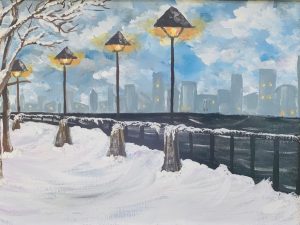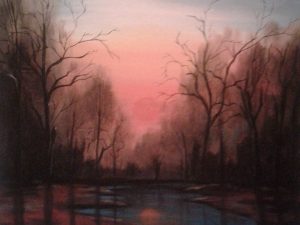The artwork presented is a textured oil painting depicting a serene winter landscape, characterized by snow-covered grounds and warmly toned houses. This assessment will cover considerations of composition, technique, palette, and the market-driven valuation to provide a robust price evaluation.
**Composition and Technique:**
The painter skillfully employs a balanced composition with a dynamic, diagonal lead created by the snowy road, drawing the observer's eye into the heart of the village. The placement of bare trees and a subtle fence line adds depth and realism to the scene. The artist's use of impasto—highly textured paint application—enhances the tactile quality of the snowy surfaces, which can add value due to the skill and increased material required for this technique.
**Scale and Materials:**
The artwork, though not specified in dimensions, appears moderate in scale based on the image provided. The use of oil paints is typical for works that desire longevity and rich coloration, factors which contribute positively to the artwork’s intrinsic value. Furthermore, the canvas substrate, presumed from the texture and presentation, is a standard choice that promises durability and a classic display quality.
**Palette:**
The color palette features a contrast between the cool, subdued whites and blues of the snow and sky and the warm yellows and oranges of the architectural elements. This juxtaposition not only draws visual interest but also evokes a comforting, almost nostalgic sense of warmth in winter. The effective use of lighting, perhaps denoting a setting or rising sun, adds a dynamic and emotive element to the work.
**Market-Driven Valuation:**
Without explicit details on the artist’s recognition or standing in the art community, the valuation must hinge on the technical and aesthetic qualities of the work itself, along with general market trends for similar styles. Landscape paintings, particularly those capturing idyllic, tranquil European village scenes, tend to perform well in both primary and secondary art markets due to their universal appeal and decorative potential.
**Price Evaluation:**
Assuming an above-average execution but no prominent artist renown, comparable works might typically range from $800 to $3,000 in today's market, depending heavily on size. This piece’s refined technique, particularly its textured surface and effective use of light and shadow, might push it towards the higher end of this spectrum. However, without established artist fame, breaking much above this range could be challenging unless presented in distinguished galleries or art shows, which can add substantial extrinsic value through provenance or exhibition history.
**Conclusion:**
Given the information provided and assuming no significant provenance, a fair market estimate for this piece would be approximately $1,500 - $2,500. This price acknowledges its technical proficiency and appealing aesthetic while considering the absence of a well-known artist signature or other value-adding historical contexts. It is recommended that the piece be positioned in a market where buyers appreciate traditional scenes and techniques, possibly enhancing its appeal through strategic storytelling about the work and its thematic resonance with rural tranquility and seasonal beauty.




